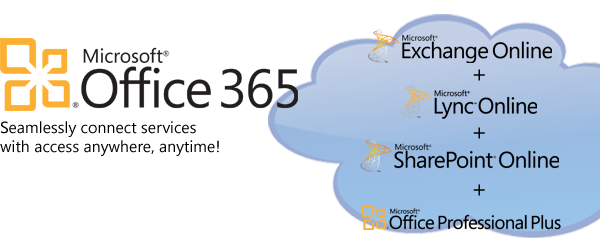The cloud is one of the hottest buzzwords in business today. I can summarize the mission statement of Microsoft® Office 365 and the Cloud in just a couple of words. Anytime, anywhere access, on any device. The Cloud is really just another term for the Internet. You have been accessing cloud services like Gmail for years now, but recently the term “Cloud” has been attached to everything and anything in IT. The landscape of business has also changed drastically and mobility is king. Employees will bring their own devices, want to work from home when possible, and also need access to company resources 24/7. Office 365 has been specifically designed for these new scenarios.

I have been working with Office 365 and its previous iteration (BPOS) for over 3 years now. It is very difficult to find exact information on what you are actually getting when you subscribe to one of the Office 365 Enterprise plan choices. It is also difficult to explain exactly what the advantage is of migrating to a product like Office 365. You must have a well thought out plan on how to take your current IT infrastructure and migrate to Office 365. It is definitely not something to just jump into.
The real advantage of a product like Office 365 is being able to mix and match the individual plans types in order to meet your specific business needs. What I have found is you have to first understand your clients’ current environment and then match those capabilities to the Office 365 plans, while at the same time presenting new capabilities and features. Office 365 presents features and capabilities that would not have even been considered a viable option to have on premise.
Even if your business only consists of five employees with laptops as their primary device you will have access to Enterprise features that would have cost you thousands of dollars in infrastructure costs and licensing. On the other side of the spectrum, Office 365 can scale to any size environment because of Microsoft’s extensive Cloud infrastructure. Another advantage is that you are demystifying software licensing and keeping a consistent manageable IT budget year after year. You can easily add or remove users and features. This will give you an exact view of where your Microsoft licensing is and you will not be asking yourself, am I in compliance with Microsoft Licensing?
Microsoft will also update their datacenters adding new features and capabilities with each iteration of Office 365. No longer do you have to plan a hardware refresh cycle for Exchange severs, SharePoint servers and Lync servers. You also have one standard web interface to manage all your online features and licensing.
All of these features can be available for as little as $8 per month / per user. As an eye opening example, the Office 365 E1 plan can provide your 15 user company with all the enterprise capabilities of a fortune 500 company for the price of one employee’s monthly cell phone bill. Once you lay it out like that, this product is truly a game changer.
As you can see, I am very excited of about Office 365 and what it can offer any size business. Working with customers the last three years has opened my eyes to what Office 365 is really capable of delivering.
In the next article I will go into detail of exactly what is contained within the Office 365 Enterprise Plans (E1 through E4).
For more information on Office 365, contact McGladrey’s technology consulting professionals at 800.274.3978 or email us. In addition, please check out our services offerings on our website.
By: Chris Clark, Supervisor – Information Technology Consulting, RSM LLP

 RSMUS.com
RSMUS.com



